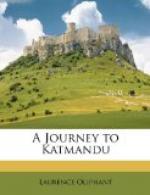The country through which this road led us was flat, stale, but not unprofitable, since on either side were paddy-fields extending ad infinitum, studded here and there with clumps of palms.
The climate was delightful, and the morning air tempted us to uncoil ourselves from our night-wrappers, and take a brisk walk in the dust; after which we mounted the coach-box, and devised sundry practical methods for accelerating our team, who however were equally ingenious in contriving to save themselves fatigue.
The mid-day sun at last ridded them of their tormentors, and we once more betook ourselves to our comfortable beds in the interior of the conveyance, there to moralize over the barbarism of a man, calling himself an enlightened Englishman, in employing men instead of horses to drag along two of his fellow-countrymen, who showed themselves even more dead to every feeling of humanity by the way in which they urged on their unfortunate fellow-creatures. These coolies were certainly very well paid, and need not have been so employed had they not chosen—for they had all applied for their several appointments—but then the ignominy of the thing!
And so we rolled lazily along, hoping to reach Benares some time within the next fortnight. Before dark we passed through Burdwan, where a few Bengal civilians vegetate on large salaries, to do the work of the rajah, who is still more highly paid not to interfere. He lives magnificently in his palace, and they live magnificently in theirs. We arrived at a small rest-house at night, where we had the satisfaction of eating a fowl in cutlets an hour after it had been enjoying the sweets of life.
There is a considerable amount of enjoyment in suddenly coming to hills after you have for a long time seen nothing but flat country—in first toiling up one and then bowling down the other side, at the imminent peril of the coolies’ necks—in seeing streams when you have seen nothing but wells—in coming amidst wood and water and diversified scenery, when every mile that you have travelled for a week past has been the same as the last. Such were our feelings as we woke at daylight one morning in the midst of the Rajmahal hills.
There were a good many carts passing with coal from the Burdwan coal-mines; moreover, we saw sticks, and from the top of each fluttered a little white flag, suggestive of a railway, whereby our present mode of conveyance would be knocked on the head, and all the poor coolies who were pushing us along would be put out of employ. Notwithstanding the disastrous results which must accrue, a railway is really contemplated; but I have heard doubts thrown out as to the present line being the best that could be obtained. It is urged that it has to contend against water carriage—that, with the exception of the Burdwan mines, the coal of which is of an inferior quality, there is no mineral produce—that immense tracts of country




